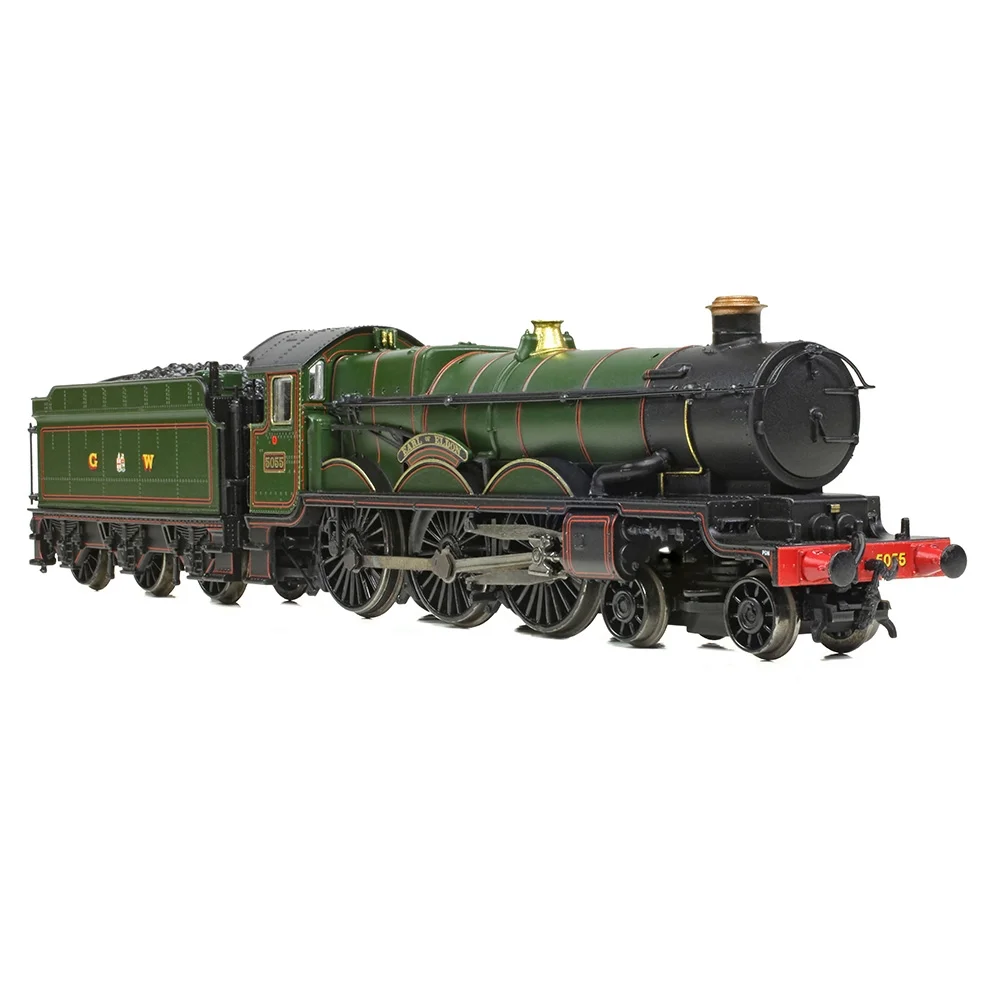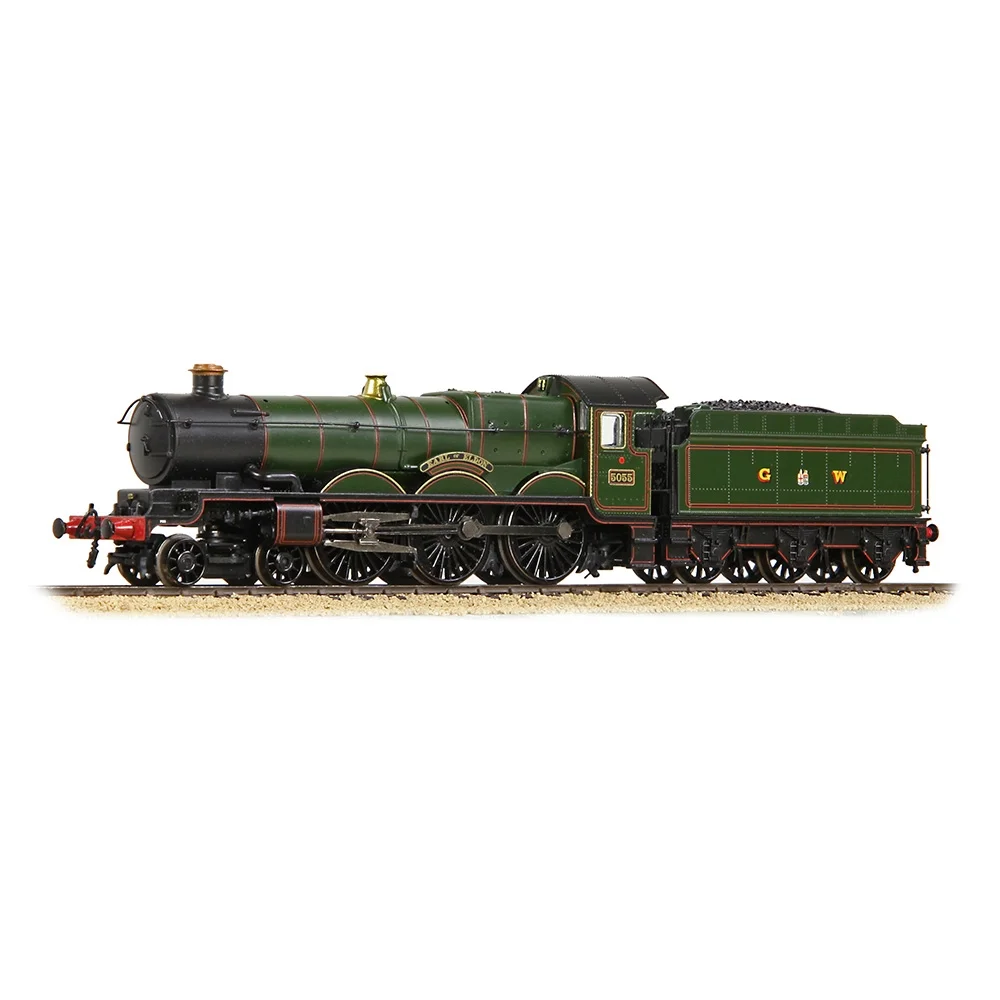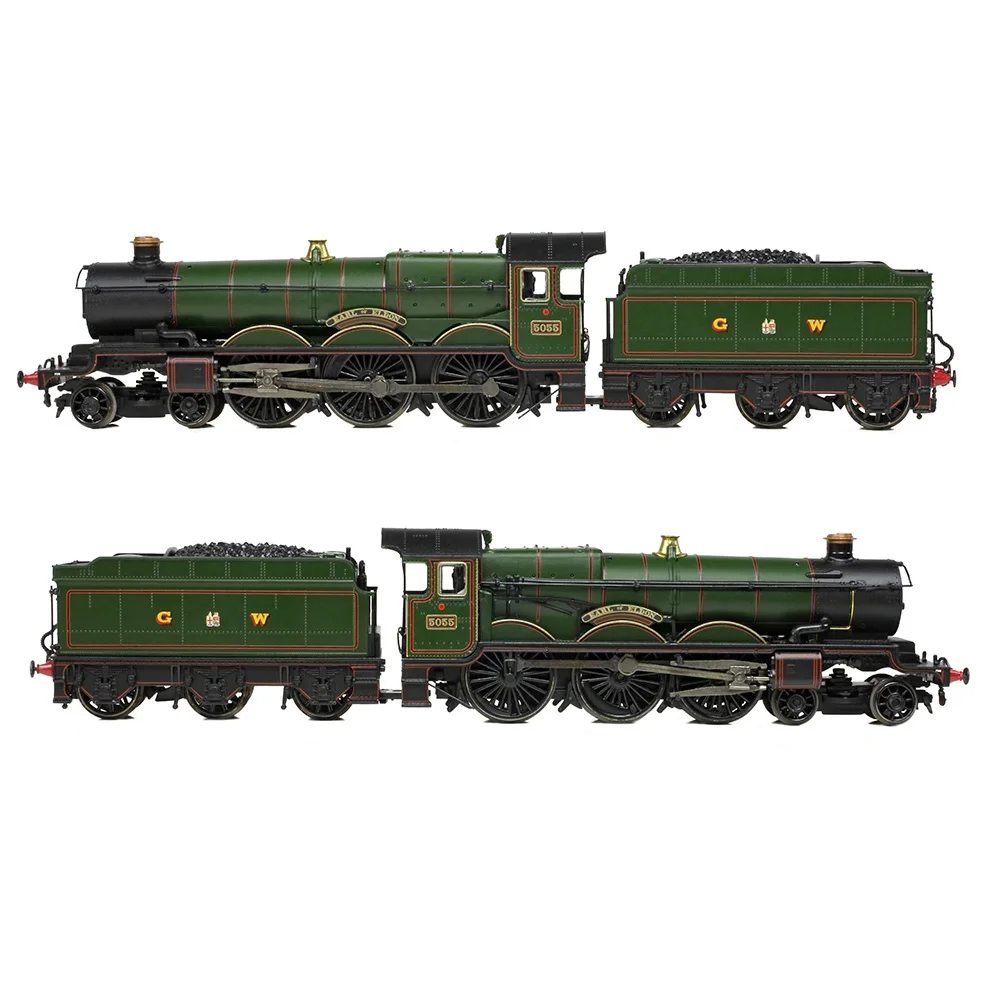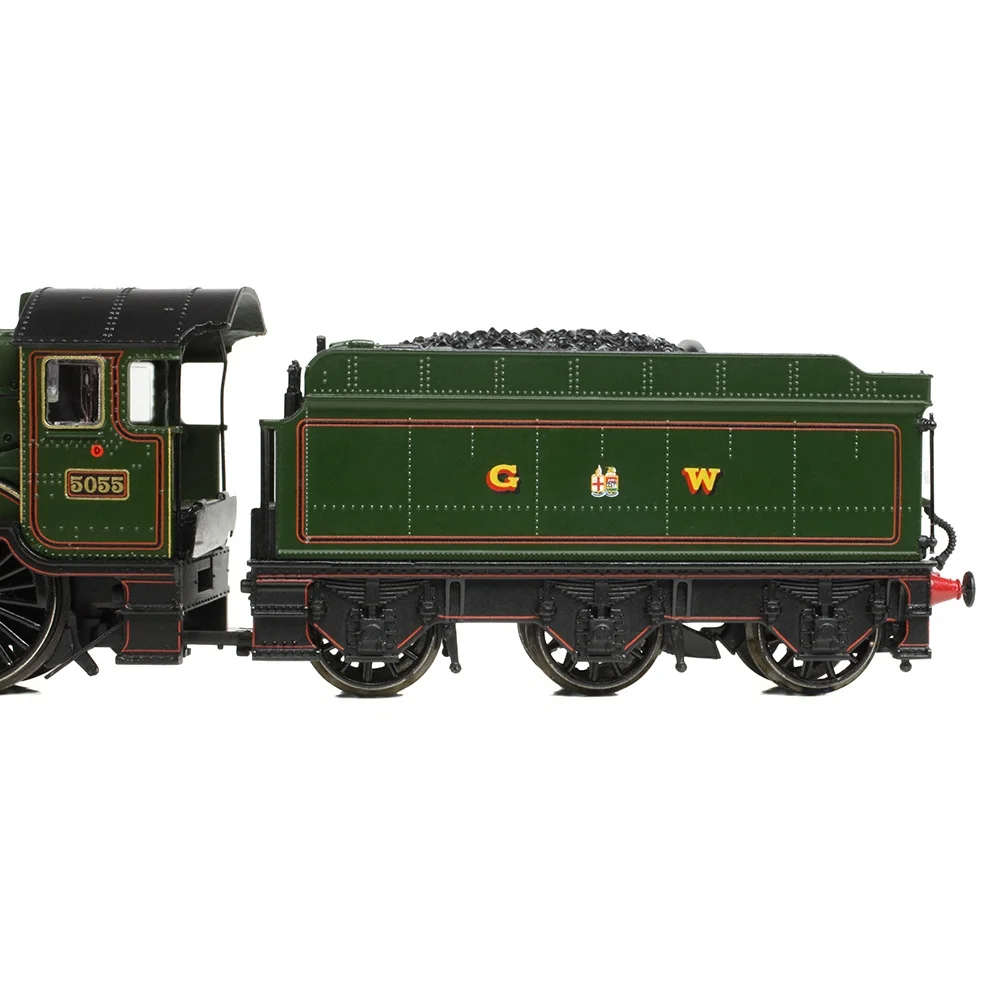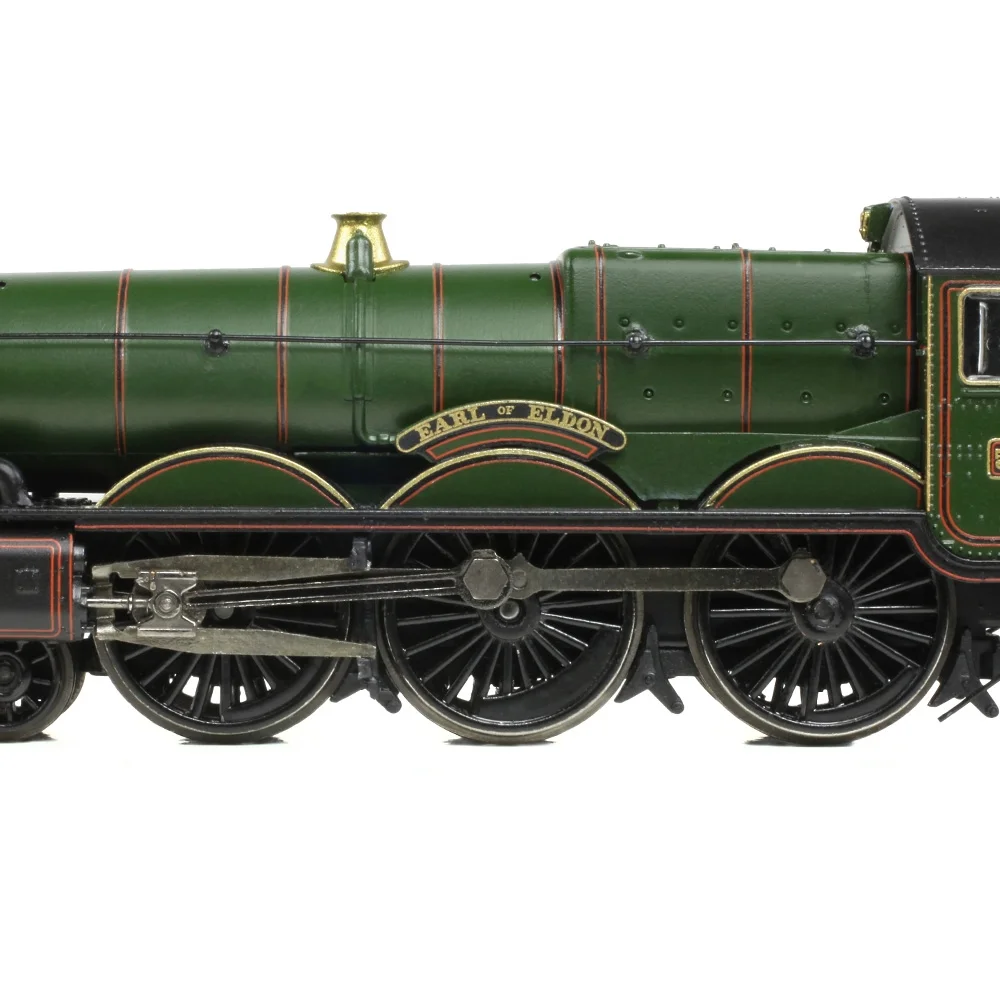Graham Farish 372-034SF
Great Western Railway 4073 Class 5055 Earl of Eldon Great Western Railway Lined Green with Crest
Graham Farish's Description & Specifications
The Graham Farish Castle Class locomotive is a worthy replica of one of the Great Western Railway’s (GWR) finest steam locomotive designs, with its elegant appearance only amplified by the beautiful lined green livery that was synonymous with the GWR, and later British Railway’s Western Region. This N scale model combines the Castle’s good looks with an exquisite paint finish to produce a masterpiece in miniature fit for any Western-inspired collection.
The model that started a revolution as the first British N Scale steam locomotive to be made with SOUND FITTED, the Graham Farish ‘Castle’ has a technical specification as impressive as its good looks, with a powerful coreless motor driving the wheels through a diecast metal gearbox, all wheel pickup from the driving and tender wheels and separate metal bearings fitted to the driving wheel axles, smooth and reliable running is guaranteed. The tender houses a speaker and Next18 DCC decoder socket, making it easy to add sound, or opt for a SOUND FITTED version and the work is done for you, so you can enjoy realistic sound effects straight from the box on both Analogue and DCC.
- Graham Farish N Scale
- Era 3
- Pristine GWR Lined Green (GW Crest) Livery
- Running No. 5055
- Named ‘Earl of Eldon’
- SOUND FITTED – Fitted with a Zimo MS590N18 DCC Sound Decoder
- Length 145mm (over couplings)
DETAIL VARIATIONS SPECIFIC TO THIS MODEL
- Collett 4,000-gallon Tender
- Single Chimney
- Inside Cylinder Chest: Box Pattern with Curved Front
- Straight Cylinder Steam Pipes
- Tapered Buffers
- Horizontal Cab Side Handrail
- Rear Sandboxes Behind Cab Steps
- Short Nameplates
MECHANISM:
- Coreless motor
- Electrical pickup from all driving and tender wheels
- Separate metal bearings fitted to each driving wheel axle
- Metal bearings fitted to each tender wheel axle
- Diecast metal chassis block
- Diecast metal gearbox, with gearing arranged for prototypical running speeds and haulage capabilities
- 9mm (N gauge) wheels to NEM310 standards with authentic profile and detailing
- Traction tyres fitted to the rear driving wheels for assured haulage capabilities
- Valve gear of metal construction
- Discreet fixed locomotive to tender drawbar with integral electrical connections
- Coupling pocket to NEM355 standards fitted to the front bogie
- Removable coupling pocket to NEM355 standards fitted to the tender chassis
- Designed to operate on curves of second radius (263.5mm) or greater
DETAILING:
- High-precision, injection-moulded bodyshell, running plate and tender with separately fitted details parts including smokebox door, lower front lamp irons, steam pipes, whistle and reverser
- Separately applied metal components including handrails, buffers and sand pipes
- Dome, filler cap, water scoop and vacuum pipe added to the tender as separate parts
- Tender fitted with metal coal-effect load
- Detailed cab interior including boiler backhead controls and gauges, brake standard and water scoop standard
- Hinged and posable metal fall plate between the locomotive and tender
- Each model supplied with a full set of accessory parts including dummy screwlink couplings and front vacuum pipe
DCC:
- Next18 DCC decoder interface located in the tender
SOUND:
- Speaker installed in the tender of all models for optimum sound reproduction
- Zimo MS590N18 DCC Sound Decoder fitted to SOUND FITTED versions
- Sound files produced specifically for the Graham Farish GWR Castle Class using recordings from real locomotives
- SOUND FITTED models operate on DCC and Analogue control as supplied
LIVERY APPLICATION:
- Authentic liveries applied to all models
- Multiple paint applications employed on each model using GWR and BR specification colours
- Logos, numerals and text added as appropriate using multi-stage tampo printing using authentic typefaces, logos and colours
- Named locomotives are supplied with pre-fitted, fully decorated nameplates
Class & Prototype
- Class: Great Western Railway 4073 Class
- Traction: Steam
- Built: 1923-1950
- Total Built: 171
- Running Number: 5055
- Name: Earl of Eldon
- Ordered By: Great Western Railway
- Built By: Great Western Railway
- Built At: Swindon
- Built: 06/1936
- Withdrawn: 09/1964
- Length of Service: 28.3 years
- Running Numbers: GWR 5055
- Names: Earl of Eldon
The GWR 4073 Castle Class represents the pinnacle of Great Western Railway express passenger design, introduced by Charles Collett in 1923. These legendary 4-6-0 locomotives famously outperformed LNER Pacifics in the 1925 exchange trials, proving their superior fuel economy and performance. With 171 built between 1923-1950, they handled premier services like the "Cornish Riviera Express" for over four decades. Eight survive in preservation, with excellent model representations available from Hornby, Graham Farish, and specialist manufacturers. Essential for any authentic GWR layout.
GWR No. 5055 Earl of Eldon was built at Swindon Works on 30th June 1936 as part of Lot 303, originally carrying the name "Lydford Castle." The locomotive was renamed "Earl of Eldon" in August 1937 as part of the Great Western Railway's decision to rename many Castle Class locomotives after British Earls rather than castles. Built during the mid-1930s expansion of the Castle Class fleet, 5055 served for 28 years before withdrawal on 30th September 1964. The locomotive was allocated to Old Oak Common (81A) at nationalisation in 1948, later moving to Gloucester Horton Road (85B) for its final years. After withdrawal, 5055 was scrapped at Cashmores, Newport on 28th February 1965. This locomotive represents the "Earl" sub-series of Castle Class locomotives, demonstrating the GWR's evolving naming conventions during the late 1930s whilst maintaining the class's exceptional mechanical reliability and performance standards.
The locomotive is notable for being part of the batch that underwent the naming change from castles to earls, reflecting the GWR's broadening of the naming theme as more locomotives were built beyond the original castle names.
Operator & Livery
- Operator: Great Western Railway
- Livery: Lined Green with Crest
- Era: 3 - The big 4 – LMS, GWR, LNER & SR
The Great Western Railway (1835-1947) was Britain's most innovative railway company, engineered by Isambard Kingdom Brunel with his revolutionary 7ft ¼in broad gauge system. Known affectionately as "God's Wonderful Railway" and the "Holiday Line," the GWR connected London Paddington with the West Country, Wales, and Birmingham through 3,800 miles of superbly engineered routes.
Renowned for its Brunswick green locomotives, chocolate and cream carriages, and engineering excellence centred at Swindon Works, the GWR pioneered advanced steam technology under chief mechanical engineers Daniel Gooch, George Jackson Churchward, and Charles Collett. The company's legendary locomotive classes—including Castle, King, Hall, and Manor—established performance standards that influenced British locomotive design for decades.
The only "Big Four" railway to retain its original identity through the 1921 grouping, the GWR maintained its distinctive corporate culture until nationalisation in 1947. Today, the company's engineering legacy lives on through extensive preservation efforts, heritage railways, and detailed model railway recreations that celebrate the finest traditions of British steam railway operation.
The GWR Lined Green with GW Crest livery represents the final evolution of Great Western Railway locomotive decoration, introduced in late 1934 and used until nationalisation in 1947. This dignified livery featured the company's distinctive Middle Chrome Green body colour with elegant orange and black lining, distinguished by the iconic "twin shield" crest displaying the coats of arms of London and Bristol side by side.
This livery replaced the earlier "shirt button" roundel branding and marked a return to heraldic insignia reflecting the GWR's founding purpose—linking the two great cities. The twin shield crest featured the arms of the City of London (St George's Cross with ceremonial sword) alongside the City of Bristol (ship and castle), symbolising the railway's role as the premier connection between the capital and the west.
Applied to all passenger and mixed-traffic locomotive classes including Castle, King, Hall, Manor, and Grange classes, this livery survived wartime austerity when most locomotives received unlined black paint. The finest examples continued to receive full lined green treatment throughout the Second World War, maintaining the GWR's reputation for locomotive presentation excellence until the company's final days in 1947.
Modelling Note: This livery is accurately represented by manufacturers including Hornby, Bachmann, and Graham Farish, with Fox Transfers providing authentic twin shield crest decals (reference FRH4104) for detailed restoration work.

